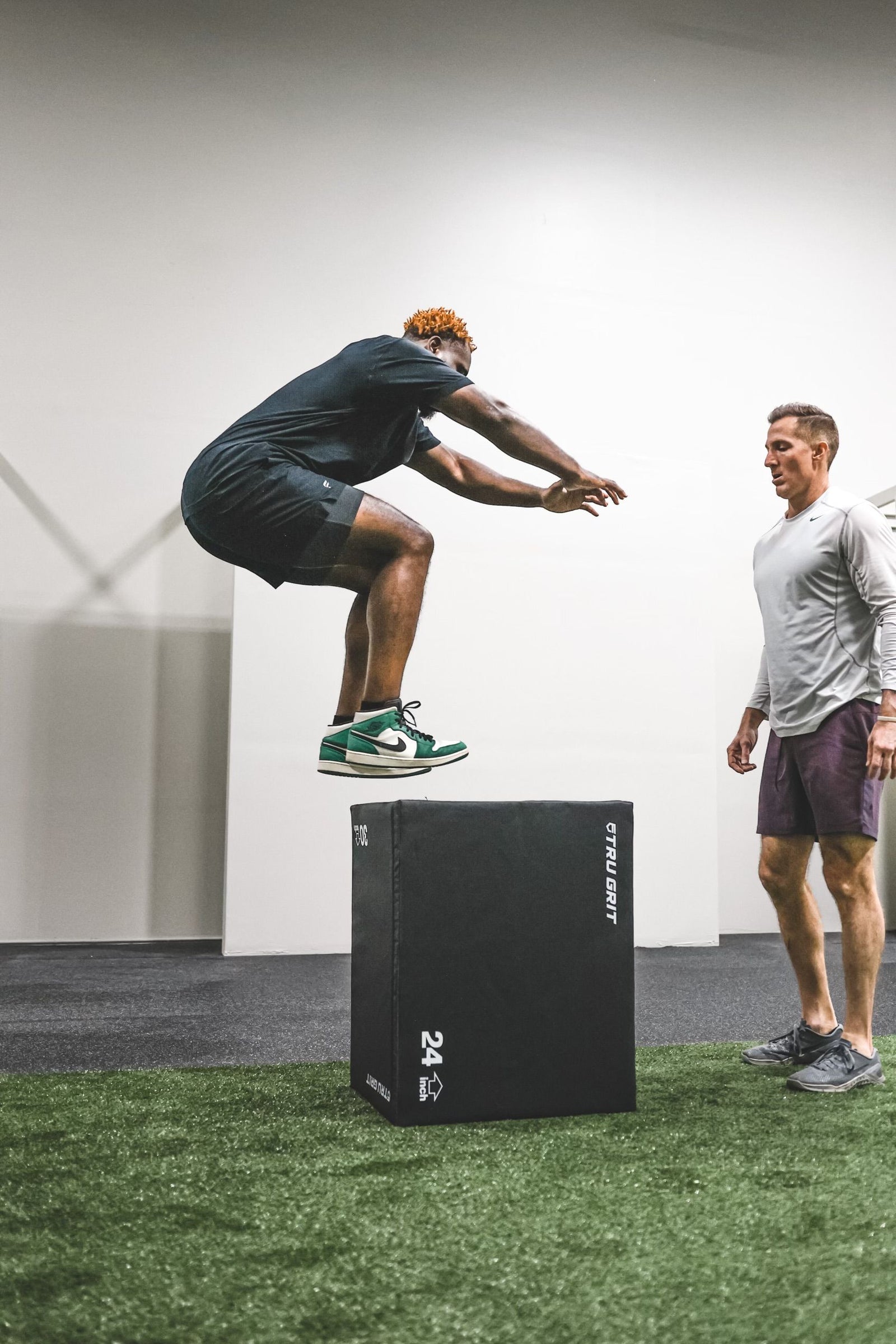03.15.2022 News
A Beginner’s Guide On How To Do Box Jumps
Whether you’ve seen fitness influencers on TikTok jump onto five-foot boxes, or fellow gym-goers use this move on leg-day, the box jump is a powerful exercise that can train your legs and improve your explosivity.
By integrating box jumps into your workout, you not only train for speed and explosiveness, but also condition your muscles to build upper and lower body strength, aiding your performance in other areas of fitness as well.1 Plus, what better way to elevate your run-of-the-mill routine than by jumping onto a surface as high as possible?
Get ready to sweat and reach new heights with your fitness goals. Here’s everything a beginner needs to know about how to perform this move correctly to better experience the many benefits of plyometric box jumps.
What are Box Jumps?
A box jump is a plyometric exercise movement that involves jumping onto a padded or wooden box as a way to work your hamstrings, quads, calves, and glute muscle region. Like other activities in the plyometric category, box jumps employ fast and forceful movement to build power.2
A versatile plyometric exercise, box jumps can be adjusted in multiple ways to suit your fitness goals. You can progress by adjusting the height or distance of the box from you or by modifying how many reps you perform at a time.
How to Do Box Jumps
Before anything else, find a box you can safely land on. A foam plyo box is good for beginners, while long-term enthusiasts might want a more versatile 3-in-1 plyo box made of plywood for both jumps and step ups.
Once you’ve found a box that works for you, follow these steps to perform a box jump correctly:3
- Step 1 – With your feet shoulder-width apart, stand about a foot’s distance from your box, facing it.
- Step 2 – Bend into a quarter-squat position, swing your arms back and then forward for momentum, as you jump off the ground.
- Step 3 – Aim to land on your box as softly as possible. For an ideal landing, aim to have your feet flat and your knees slightly bent. If your knees are bent too far in a deep squat as you land, this could be an indicator that the box is too high. If that’s the case, you may want to consider sizing down before gradually increasing the height of your box.
- Step 4 – From the box, step down with one leg at a time. This safeguards your hamstrings while working your glute muscles.
- Step 5 – Repeat this movement for the desired number of repetitions. Three to five repetitions per set is a good place for beginners to start from.
4 Common Box Jump Mistakes To Avoid
Now that you’ve got the basic motions down, watch out for these common beginner mistakes before you integrate box jumps into your cardio workout routine.
#1 Starting With a Box That’s Too High
Aiming for the stars is usually a healthy mindset—but maybe not the best advice to heed when box jumping. A common beginner mistake is to enthusiastically choose a box that’s too high to jump onto.
Again, you may notice a box is too high if you naturally land in a deep squat as opposed to a quarter squat. In worse cases, you’ll end up smashing your shins on it or noticing a few aches and pains in your knees over time.
The best practice? Start with a box height of around 20 inches and work on your box jump form before scaling up.4
#2 Jumping Off Instead Of Stepping Down
It might seem fun to jump off your box as a way to practice the movement backward, but this might not be the safest choice—especially when you’re just starting out. When performed backwards, plyometric movements, like box jumps, can put a lot of stress on the Achilles tendon.5 Wreckless dismounts not only risk injury but can also tire your muscles out faster as you progress through your cardio workout. Always step off the box one leg at a time.
#3 Landing Incorrectly
Landing a box jump with incorrect foot and knee alignment won’t exactly be doing your body any favors. When your knees extend too far past your toes or cave inward as you land, this places excessive stress on your knee joint. The pain from joint stress could put a pause on your daily box jump workout or even set the stage for long-term injuries.6
When starting off with the box jump, practice landing with your knees bent slightly in line with your toes, and work on landing as softly as you can. If you notice your knees caving inward, work on building your glute muscles using isolation movements like glute bridges before you take up box jumps.7
#4 Leaving Box Jumps For The End
Box jumps are a powerful movement that require full body explosivity to perform safely. To ensure you avoid hurting your shins, falling, or landing incorrectly, always perform box jumps at the beginning of any workout routine. Harness the energy from your pre-workout shake and channel it into this plyometric movement shortly after lacing up your sneakers for a new session.
Build Explosive Strength With Tru Grit
Who said box jumps were for plyo-enthusiasts only? Tru Grit’s range of plyo boxes are geared for customization so you can find the perfect accessory for everything from box jumps to step ups. With sanded edges, the 3-in-1 Plyo Box prevents scraped shins from missed jumps and the robust foundation of our padded Foam Plyo Box helps absorb the impact from your landing.
Jump into action today with Tru Grit.
Sources:
Coach Mag. How To Do Box Jumps. https://www.coachmag.co.uk/leg-exercises/6458/how-to-do-box-jumps
Stack. 3 Common Mistakes That Might Be Holding You Back. https://www.stack.com/a/3-common-box-jump-mistakes-that-could-be-holding-you-back/
Trifect Therapeutics. Knees Caving In When Squatting/Jumping? Here’s Your Fix for Knee Valgus. https://www.trifectatherapeutics.com/blog/knees-caving-in-when-squattingjumping-heres-your-fix-for-knee-valgus
 Now Accepting HSA/FSA
Now Accepting HSA/FSA

